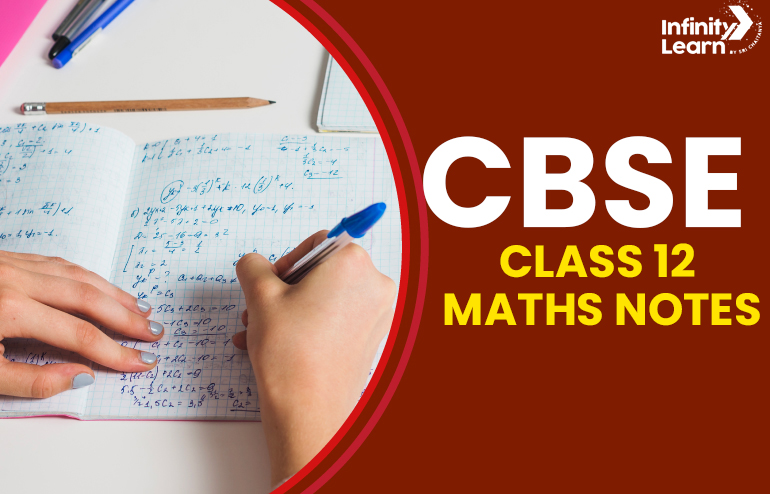Table of Contents
CBSE Class 12 Maths Notes are crucial for scoring high marks and building a strong foundation in Mathematics. Daily practice is essential, especially for topics like calculus, vectors, and 3D geometry. Solving sample papers and previous year question papers is key to understanding question patterns and difficulty levels.
Students should practice extensively from all chapters to confidently tackle any question in the board exam. CBSE Class 12 Maths Notes facilitate easy revision of various topics, enhancing exam preparedness. Accessing these notes can significantly improve exam readiness and performance.
CBSE Maths Notes For Class 12 Pdf Free Download

The subject experts make the CBSE Class 12 Maths Notes provided in the article below to cover all the Fundamentals Of Mathematics Class 12 to help the students in their exam preparation. These Maths Notes for Class 12 are designed in the most simple format which could be understood easily. Preparing from these notes can help you to score outstanding marks in the Class 12 examination and will also help you to revise the basic concepts for JEE main 2024 and JEE advanced 2024 examinations.
To access them click on the respective chapter link.
- Chapter 1 Relations and Functions
- Chapter 2 Inverse Trigonometric Functions
- Chapter 3 Matrices
- Chapter 4 Determinants
- Chapter 5 Continuity and Differentiability
- Chapter 6 Applications of Derivatives
- Chapter 7 Integrals
- Chapter 8 Applications of Integrals
- Chapter 9 Differential Equations
- Chapter 10 Vector Algebra
- Chapter 11 Three-dimensional Geometry
- Chapter 12 Linear Programming
- Chapter 13 Probability
Detailed Chapters from Class 12 Maths (2023-2024)
- Relations and Functions: Covers the study of relations and functions between sets, including types of functions, their properties, and graphical representations.
- Inverse Trigonometric Functions: Focuses on inverse trigonometric functions such as arcsine, arccosine, and arctangent, their properties, graphs, and applications.
- Matrices: Introduces matrices, their operations (addition, subtraction, multiplication), properties, determinants, and applications in solving systems of linear equations.
- Determinants: Delves deeper into determinants, their properties, evaluation techniques, and applications, particularly in solving systems of linear equations and finding areas/volumes.
- Continuity and Differentiability: Explores the concepts of continuity and differentiability of functions, including their definitions, criteria, and basic techniques for differentiation.
- Application of Derivatives: Applies differentiation techniques to solve problems related to maxima, minima, rates of change, optimization, and related rates.
- Integrals: Introduces integration, including indefinite and definite integrals, integration techniques, and applications such as area under curves and volumes of revolution.
- Application of Integrals: Further explores applications of integration, including finding areas between curves, lengths of curves, volumes of solids, and physical applications like work and force.
- Differential Equations: Covers differential equations, their classifications, solution techniques (separation of variables, integrating factors, etc.), and applications in various fields like physics, engineering, and biology.
- Vector Algebra: Introduces vectors and their algebraic operations, including dot and cross products, vector equations of lines and planes, and applications in geometry and physics.
- Three-Dimensional Geometry: Studies points, lines, planes, and geometric shapes in three-dimensional space, including distance and angle measures, equations of planes, and intersections.
- Linear Programming: Introduces linear programming problems, their formulation, solution techniques (graphical, simplex method), and applications in optimization.
- Probability: Covers basic probability concepts, including sample spaces, events, probability laws, conditional probability, random variables, probability distributions, and applications in various fields.
Benefits of Studying from CBSE Maths Notes of Class 12
- Maths notes offer a concise overview of each chapter
- Allowing students to quickly revise important formulas and theorems.
- They save time and help students recall key concepts, making them invaluable for exam preparation.
CBSE Class 12 Syllabus 2024 for All Subjects
CBSE Class 12 Maths Formulas
Below given table provides the link for CBSE Maths class 12 important formula sheets.
CBSE Class 12 Maths Notes: FAQs
Is CBSE Class 12 maths very hard?
Difficulty varies from person to person, but CBSE Class 12 Maths is generally manageable with effort.
How to get 100 in maths class 12?
Consistent practice, understanding concepts thoroughly, solving a variety of problems, seeking help when needed, and using effective study techniques can contribute to achieving a high score in the CBSE Class 12 Maths Examination.
What is the hardest chapter in CBSE Class 12 Maths?
Differential Equations (Chapter 9) and Three-Dimensional Geometry (Chapter 11) are commonly considered challenging in CBSE Class 12 maths.
How to get 95 percent in Maths class 12?
Utilize the prescribed textbooks, reference materials suggested by your teacher, and explore online resources such as educational websites, video lectures, and practice exams to supplement your study material. Adopt effective study techniques like creating a study schedule, breaking down topics into manageable sections, solving past exam papers, collaborating with study groups, and seeking guidance from teachers when needed.







